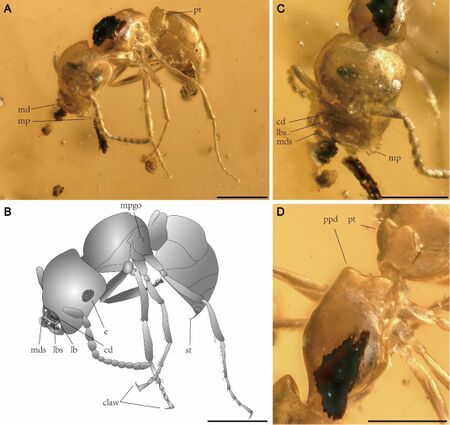Zigrasimecia zui
| †Zigrasimecia zui Temporal range: Early Cenomanian, Late Cretaceous Burmese amber, Kachin State, Myanmar | |
|---|---|
| Scientific classification | |
| Kingdom: | Animalia |
| Phylum: | Arthropoda |
| Class: | Insecta |
| Order: | Hymenoptera |
| Family: | Formicidae |
| Subfamily: | Zigrasimeciinae |
| Genus: | Zigrasimecia |
| Species: | †Z. zui |
| Binomial name | |
| †Zigrasimecia zui Zhuang, Liu, Ran, Jarzembowski & Zhang, 2023 | |
Photo Gallery
 Zhuang et al. (2023), Fig. 1. Worker of yZigrasimecia zui sp. n., holotype, YKLP-AMB-005. All scale bars ¼ 0.5 mm. (A), photograph of body lateral view. (B), interpretive drawing of YKLP-AMB-005 in lateral view. (C), photograph of head, frontal view. (D), photograph of mesosoma, dorsal view. Abbreviation: cd ¼ clypeal denticles; e ¼ compound eye; lb ¼ labrum; lbs ¼ labial setae; mp ¼ maxillary palp; mpgo ¼ metapleural gland opening; mds ¼ mandibular setae; ppd ¼ propodeum; pt ¼ petiole; st ¼ sting.
Zhuang et al. (2023), Fig. 1. Worker of yZigrasimecia zui sp. n., holotype, YKLP-AMB-005. All scale bars ¼ 0.5 mm. (A), photograph of body lateral view. (B), interpretive drawing of YKLP-AMB-005 in lateral view. (C), photograph of head, frontal view. (D), photograph of mesosoma, dorsal view. Abbreviation: cd ¼ clypeal denticles; e ¼ compound eye; lb ¼ labrum; lbs ¼ labial setae; mp ¼ maxillary palp; mpgo ¼ metapleural gland opening; mds ¼ mandibular setae; ppd ¼ propodeum; pt ¼ petiole; st ¼ sting. Zhuang et al. (2023), Fig. 3. 3D-reconstruction of YKLP-AMB-005. Scale bars for (A), (B) ¼ 0.1 mm, for (C), (D) ¼ 0.2 mm. (A), head in frontal view. (B), body in lateral view. (C), body in dorsal view. (D), body in ventral view. Abbreviation: cd ¼ clypeal denticles; e ¼ compound eye; lcp ¼ laterocervical plate; lb ¼ labrum; md ¼ mandible; lp ¼ labial palp; mn ¼ mesonotum; mp ¼ maxillary palp; oc ¼ ocelli; pn ¼ pronotum; ppd ¼ propodeum; pt ¼ petiole; sl ¼ scutellum; ts ¼ tibial spur; st ¼ sting.
Zhuang et al. (2023), Fig. 3. 3D-reconstruction of YKLP-AMB-005. Scale bars for (A), (B) ¼ 0.1 mm, for (C), (D) ¼ 0.2 mm. (A), head in frontal view. (B), body in lateral view. (C), body in dorsal view. (D), body in ventral view. Abbreviation: cd ¼ clypeal denticles; e ¼ compound eye; lcp ¼ laterocervical plate; lb ¼ labrum; md ¼ mandible; lp ¼ labial palp; mn ¼ mesonotum; mp ¼ maxillary palp; oc ¼ ocelli; pn ¼ pronotum; ppd ¼ propodeum; pt ¼ petiole; sl ¼ scutellum; ts ¼ tibial spur; st ¼ sting.
Identification
Differs from Zigrasimecia ferox as follows:
- scape relatively longer, flagellomere X relatively short (SL/PL ¼ 2.70 vs 1.90; SL/FXL ¼ 2.44 vs 1.58)
- compound eye flat, not convex
- less numerous ommatidia, ~30 vs >200
- frontal carinae present not absent
- ring-like toruli shallow, not convex
- mandible with smooth surface, without setae on dorsal side
- petiole more developed
- gastral setae curved and sparse, rather than straight and dense
Differs from Zigrasimecia hoelldobleri as follows:
- scape relatively longer, flagellomere X relatively short (SL/FXL ¼ 2.44 vs 2.00)
- compound eye flat, not convex
- less numerous ommatidia, ~30 vs >200
- head setae sparse and short, not long and straight
- ring-like toruli shallow not convex
- mandible with smooth surface, without setae on dorsal side
- propodeal posterodorsal margin concave
- petiole more developed
- gastral setae curved and short, rather than straight and long
Differs from Zigrasimecia boudinoti as follows:
- small body size not large
- body setae curved and short not erected and long
- less numerous ommatidia, ~30 vs >150
- propodeal posterodorsal margin concave
- petiolar node apex smooth not sharp
Differs from Zigrasimecia caohuijiae as follows:
- head frontal view with edges approximating obtuse rectangles
- less numerous ommatidia, ~30 vs ~50
- propodeal posterodorsal margin concave
- petiolar node dorsal surface middle concave
Differs from Zigrasimecia chuyangsui as follows:
- more smaller body size
- head flat
- mesosoma more slender not compact
- short body setae sparsed and curved, not abundant and long
- less numerous ommatidia, ~30 vs ~90
- propodeal posterodorsal margin concave
- petiole node more developed
Differs from Zigrasimecia perrichoti as follows:
- more smaller body size
- head surface more smooth
- body setae more pronounced
- less numerous ommatidia, ~30 vs ~90
- propodeal posterodorsal margin concave
- petiole apex bilobed not transversally
Differs from Zigrasimecia thate as follows:
- more smaller body size
- no subflagellate or hook-shaped setae on the frontovertexal region, rather curved and short
- head more flatter not convex
- clypeal lobes absent not developed
- petiolar node not particularly tilted in lateral view
Identification is supported by the following features which are, however, not necessarily unique among Zigrasimecia species.
- frontal aspect of head nearly square (aspect ratio approx. 1)
- compound eyes small, hemispherical
- clypeaus sub-rectangular
- posterior clypeal margin not distinct
- mandible flattened and sickle-shaped with smooth surface in frontal view
- notum in mesosoma not evident
- propodeum concave in middle
- petiolar node broad, apically slightly concave
- abdominal segment III large
Distribution
This taxon was described from Burmese amber, Kachin State, Myanmar (Early Cenomanian, Late Cretaceous).
Castes
Nomenclature
The following information is derived from Barry Bolton's Online Catalogue of the Ants of the World.
- †zui. †Zigrasimecia zui Zhuang et al., 2023: 2, figs. 1, 3 (w.) MYANMAR (Burmese amber).
Type Material
- Holotype YKLP-AMB-005, worker. Type locality and stratigraphy. Hukawng Valley, Kachin Province, northern Myanmar. Upper Albianelower Cenomanian (ca. 98.79 ± 0.62 Ma).